Customer retention is a business’s ability to have the same customers or clients repurchase from them—which is vital for sustaining and growing revenue. Depending on your business and specific needs, various products like automation tools, loyalty management systems, and customer relationship management (CRM) software can help maintain your current customer base by keeping them satisfied through communication, activity tracking, and ticketing tools.
Based on our evaluation, the 12 best customer retention software tools include:
- Best for business-to-business (B2B) sales retention: Freshsales
- Great all-in-one retention tool: HubSpot CRM Suite
- Excellent for its free ticketing system: Freshdesk
- Best retention tool for providing omnichannel support: Zendesk
- Solid for automating email campaigns: Mailchimp
- Great platform for retaining software subscribers: Customer.io
- Best tool for obtaining customer feedback: Qualaroo
- Awesome product for retaining website visitors: Hotjar
- Best for creating advanced loyalty programs: YotPo
- Great tool to administer product giveaway contests: Woorise
- Most cost-friendly social media tools: Buffer
- Best social media tool for customer feedback: Sprout Social
Best Customer Retention Software Compared
Provider | Starting Monthly Price* | Free Plan | Type of Software |
|---|---|---|---|
$15 per user | ✓ | CRM system | |
$30 | ✓ | CRM system | |
$15 per user | ✓ | Customer management software | |
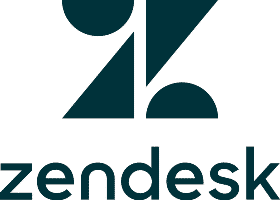 | $49 | ✕ | Customer management software |
$13 | ✓ | Automation tool | |
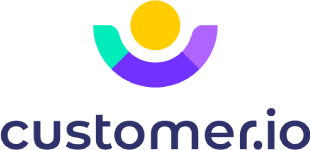 | $100 | ✕ | Automation tool |
$79 | ✕ | Customer experience management system | |
$32 | ✓ | Customer experience management system | |
$199 | ✓ | Loyalty management tool | |
$23 | ✓ | Loyalty management tool | |
$5 | ✓ | Messaging and social media tools | |
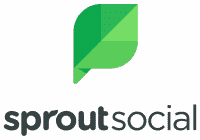 | $249 | ✕ | Messaging and social media tools |
*Based on annual billing. Monthly billing is also available for slightly higher rates.
Best CRM Systems for Customer Retention
Customer relationship management (CRM) software allows businesses to oversee their sales process, manage leads and deals, engage customers, and track activity in one interface. Many CRMs include features for assisting customers, like contact storage, communication via phone or email, and account management. A CRM is highly valuable for its all-in-one functionality, where you can handle sales, marketing, and sometimes service functions in one platform.
1. Freshsales: Best for B2B Customer Retention

Pros
- Free plan available with cost-scalable paid plans
- Built-in account management module for tracking, supporting, and maintaining clients
- Complete omnichannel communication system to support customers via phone, email, live chat, chatbot, and text
Cons
- Has no social media features to engage customers through LinkedIn, Facebook, or Twitter
- Profile enrichment for keeping customer records automatically up to date gets expensive
- Not ideal for ecommerce businesses; limited content management tools and ticketing require separate Freshdesk product
- Contact and account management modules: Freshsales is a top-notch account management solution. Users can store customer contact information, and track transactions, and communications activity. It also auto-enriches profiles with current data to ensure reps have the best available information. There are also built-in meeting scheduling tools for customers to easily schedule appointments whenever they need support.
- Omnichannel communication tools: Teams can engage customers personally through a built-in phone, email, live chat, text, or artificial intelligence (AI) chatbot to promote products or services and assist clients. There’s also integration with messenger tools like Facebook Messenger, WhatsApp, and Google Business for expanded communication.
- Personalized bulk email with sequences: Users can keep their business fresh in their customers’ minds, streamline onboarding, and automate outreach using mass email tools. There are also personalization options where you can send bulk emails while inserting CRM data in the contact or account records.
Freshsales uses a tiered subscription system for its users with the following plan options:
- Free: $0 for three users to get access to the Growth plan
- Growth: $15 per user
- Pro: $39 per user
- Enterprise: $69 per user
*Based on annual billing on a per-month basis. Monthly billing is also available for higher rates. Freshsales offers a 21-day free trial and optional paid add-ons for additional workflow automations and phone credits starting at $5. Pricing reflects pricing info available at the time of publishing. While we update pricing information regularly, we encourage our readers to check current pricing here.
Our Expert Opinion
Freshsales is a great retention software specifically for account-based businesses. It’s an especially notable business-to-business (B2B) CRM through its account management module, built-in telephone, and invoice generation tools which let you track and engage B2B clients in an efficient manner. Freshsales is also a cost-effective solution with a free plan and low-cost paid plans that allow you to execute new business and retention strategies in one platform.
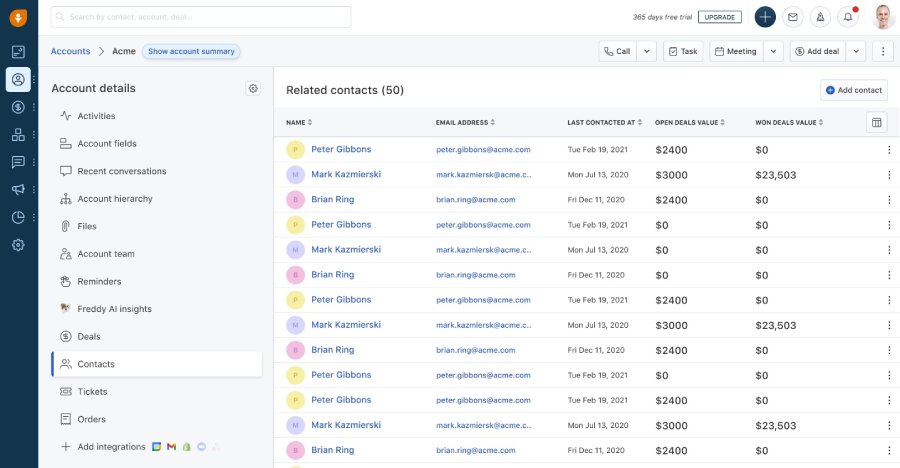
Freshsales viewing account contacts (Source: Freshsales)
2. HubSpot CRM Suite: Best for Multi-functional Retention

Pros
- Robust free-forever plan that allows up to five users
- All-in-one sales, marketing, service, and content management platform that gives a complete range of customer retention tools
- Highly intuitive features and interface that requires only a slight learning curve
Cons
- Paid plans get expensive on the higher tiers
- Users can’t engage customers on social media until the Professional plan
- Only one meeting schedule link and one ticket pipeline allowed on the Free plan
- Marketing Hub: Teams can run and automate marketing campaigns to customers via mass email, social media, and ads to help maintain the relationship. There are also live chat and artificial intelligence (AI) chatbots that assist customers who need support. Finally, you can use list segmentation features to ensure you’re sending the right content to the right customer audience to maximize campaign results.
- Service Hub: Users can keep customers satisfied with a ticketing system that lets them send in requests or questions via email, web form, chat, or phone. From there, users can monitor the status of their ticket requests to ensure timely resolutions.
- Content Management Hub: The content management system (CMS) lets you engage customers using blog articles and an on-demand video library. Users can manage and host the blogs and video library as well as send the content as links during email marketing campaigns, which can be personalized based on an audience segment.
HubSpot CRM Suite uses a tiered subscription system for its users with the following plan options:
- Free: $0 for up to five users
- Starter**: $30 for up to two users
- Professional**: $1,200 for up to five users
- Enterprise**: $5,000 for up to 10 users
*Pricing is based on annual billing on a per-month breakdown. Monthly billing is available for a higher cost. Each plan offers a 14-day free trial. Pricing reflects pricing info available at the time of publishing. While we update pricing information regularly, we encourage our readers to check current pricing here.
**Pricing uses the costs of the complete CRM Suite. Individual Sales, Marketing, Customer Service, Content Management, and Operations Hubs can also be purchased for a lower monthly rate.
Our Expert Opinion
HubSpot CRM Suite is a premium solution if you want to employ customer retention strategies in a CRM through all channels. The complete suite makes up the five HubSpot products: Sales, Marketing, Customer Service, Content Management System (CMS), and Operations Hubs. While it does get expensive, you can use the platform to retain business by optimizing ticket pipelines, automating CRM campaigns, delivering relevant content, and supporting customers on numerous channels.
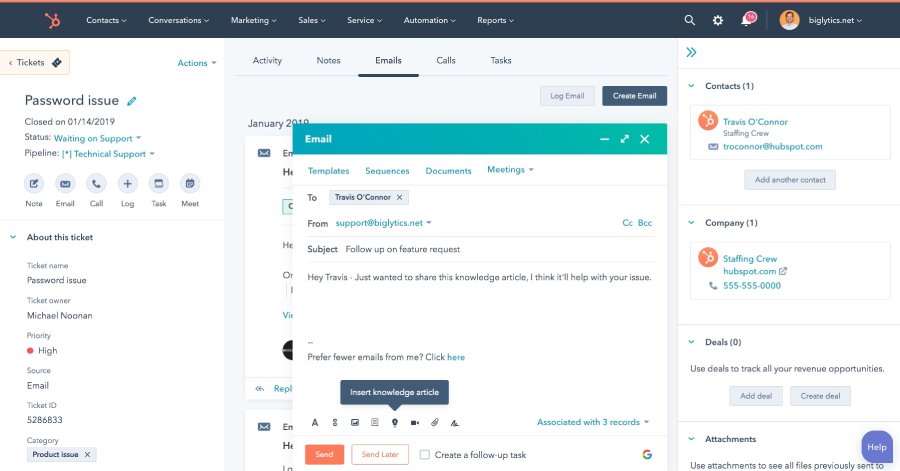
HubSpot CRM Suite free ticketing tools (Source: HubSpot)
Best Customer Service Management Tools
Prominent customer service software specifically helps in tracking data records and managing service tickets. The have great retention tools for ensuring inquiries, issues, or other requests are resolved in a timely manner on the channel most appealing to the customer.
3. Freshdesk: Best Free Ticketing Software

Pros
- Excellent free plan with ticketing tools, reporting, and knowledge base management
- Robust help desk software that lets you manage, automate, track, and improve customer service to maximize retention
- Highly customizable and has over 1,000 integrations to tailor for your operation and connect with other customer retention tools
Cons
- Mostly a ticketing system; omnichannel product for assisting and messaging on all channels requires additional cost
- Service level agreement (SLA) management not included on Free plan
- Satisfaction surveys require the Pro plan
- Integrated ticket management: Teams can collect, track, assign, escalate and resolve customer requests to maintain satisfaction through fast resolution times. Users can directly create tickets out of emails or social media, directly send knowledge base resources for self-service, and deploy surveys. You can also use service level agreement (SLA) tools on the Growth plan to align support with contract expectations.
- Support automation: Users can boost efficiency and quickly resolve customer issues with automated workflows. Collision detection identifies if multiple agents are on one ticket, round-robin assignment for auto-routing tickets to agents, and canned responses that quickly answer common questions in one click.
- Service reporting tools: Managers can track their support desk performance and efficiency by generating reports and monitoring activity on the dashboard. Additionally, you can evaluate survey results to see which areas of your service need improvement.
Freshdesk uses a tiered subscription system for its users with the following plan options:
- Free: $0 for up to 2 users
- Growth: $15 per user
- Pro: $49 per user
- Enterprise: $79 per user
*Pricing is based on annual billing on a per-month breakdown. Monthly billing is available for a higher cost. Each plan offers a 21-day free trial. Pricing is based specifically on the Support Desk product. Users can also subscribe to an Omnichannel, Customer Success Management, and Contact Center product for a higher cost. Pricing reflects pricing info available at the time of publishing. While we update pricing information regularly, we encourage our readers to check current pricing here.
Our Expert Opinion
Freshdesk offers a cost-friendly yet robust way to ensure customers get the best possible service. The main use case is its ticketing system for agents to receive, assign, track, and assist customer inquiries and requests. We like how it’s easy to use and available starting on the free-forever plan. Additionally, as self-service support is increasingly becoming a desired attribute for a customer, we also like that you can manage a knowledge base for your clients.

Freshdesk viewing all tickets (Source: Freshdesk)
4. Zendesk: Best for Customer Retention Tools for Providing Omnichannel Support

Pros
- Complete communication tools to assist customers through phone, email, live chat, chatbot, and social messaging channels
- Allows teams to enhance the customer experience by providing self-service resources like a help center and community forum
- Includes robust service level agreement (SLA) tracking to ensure teams meet client contract expectations with timely resolutions
Cons
- No free plan and paid plans get relatively expensive
- Features can be challenging to use—particularly for new users
- Multiple ticket forms and surveying require Suite Growth plan
- Omnichannel communication tools: Businesses can give their customers various methods to submit inquiries and contact support through email, web forms, phone, live chat, bots, and social media messaging. Users can also send multilingual content, self-service resources, and surveys through email, chat, or bots.
- Ticketing system: Agents can connect customer conversations and receive requests in one interface to keep satisfaction high. Through the centralized system, they can track and assign tickets, send customers resources, and escalate tickets to managers for more serious issues. There’s also service level agreement (SLA) tracking to ensure there’s no breach of a contract agreement.
- Help center and self-service management: Teams can give their customers an alternative method to get the support they need through self-service resources. From the Zendesk system, you can create and manage a help center full of valuable articles and community forums. The help center also extends to internal resources so agents can provide the best possible service to keep customers happy.
Zendesk uses a tiered subscription system for its users with the following plan options:
- Suite Team: $49 per user for up to five users
- Suite Growth: $79 per user for up to five users
- Suite Professional: $99 per user for five users
- Suite Enterprise: Contact for pricing
*Pricing is based on annual billing on a per-month breakdown. Monthly billing is available for a higher cost. Each plan offers a 30-day free trial. Pricing is based specifically on the Support Desk product. Pricing reflects pricing info available at the time of publishing. While we update pricing information regularly, we encourage our readers to check current pricing here.
Our Expert Opinion
Zendesk is an advanced customer retention management platform specifically for providing exceptional service and resources. The omni-communication capabilities enable agents to receive tickets and remain available to their customers on any desired channel, such as phone, email, live chat, social media, and chatbot. Client experience can also be enhanced by creating detailed self-service resources like a help center for do-it-yourself support.
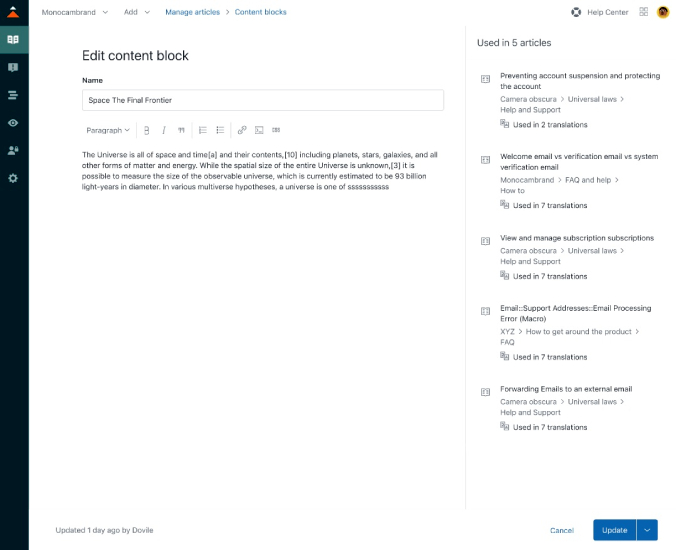
Zendesk creating help center article (Source: Zendesk)
Best Automation Software for Customer Retention
Customer retention systems with sales or marketing automation tools allow you to efficiently maintain relationships by putting customer journeys on auto-pilot. Rather than reaching out manually to someone you think will most likely desire a specific product offering or promotion, you can create automated workflows that track audience history, segment customers into lists, and deploy relevant content through email or text.
5. Mailchimp: Best for Email Automation

Pros
- Free and low-cost plans available for creating email campaigns to keep in contact with customers
- Email marketing tools are highly intuitive and come natural to most users
- Providers offers premade customer journey flows and email templates to make it easy to automate campaigns
Cons
- Only one user can be on the Free plan, which has a 500-contact limit
- Pricing is based on plan and the number of stored contacts; costs can quickly add up if you grow too fast
- Tracking customer lifetime value (CLV) and purchase likelihood insights require Standard plan
- Automated customer journeys: Teams can enhance the customer experience by creating and automating personalized customer journeys. Based on customer profiles, email engagement history, and preset triggers, users can deploy relevant marketing emails to present their products, services, and promotions, as well as deploy surveys. There’s also the option to build journeys from scratch or use prebuilt journey flows.
- Email campaign management: Teams can create mass email campaigns with customizable content from scratch or using professional email templates. They can also schedule email deployment and run A/B tests on emails to ensure the right content is getting into the right inboxes.
- Performance reporting and analytics: Users can track campaign performance through downloadable reports, real-time dashboards, and analytics. They can directly compare different campaigns, content, landing pages, and audiences to find insights on how to best engage customers and improve their overall journey.
Mailchimp uses a tiered subscription system for its users with the following plan options:
- Free: $0 for one user
- Essentials: $13 for three users
- Standard: $20 for five users
- Premium: $350 for unlimited users
*Pricing is based on annual billing on a per-month breakdown. Monthly billing is available for a higher cost. Mailchimp offers a 30-day free trial. Pricing is based specifically on the Marketing Platform for up to 500 contacts. The monthly cost slowly rises as more contacts are stored. Pricing reflects pricing info available at the time of publishing. While we update pricing information regularly, we encourage our readers to check current pricing here.
Our Expert Opinion
Mailchimp is one of the best email automation platforms, particularly helpful in connecting with ecommerce customers. Based on profiles, purchase history, and prior engagement, users can easily segment their customers into lists and deploy campaigns that provide relevant content to the recipient. Lots of the value of this customer retention platform is from the premade automated journeys and templates that save you time while managing campaigns.
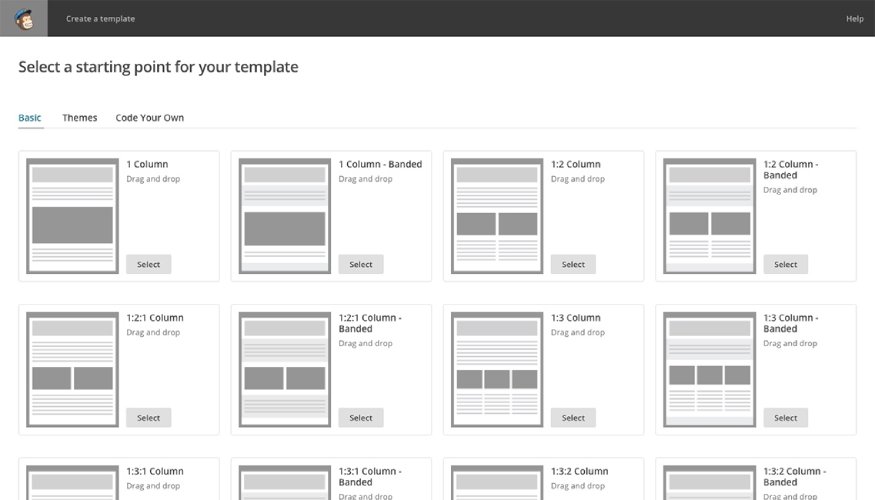
Mailchimp creating emails from templates (Source: Mailchimp)
6. Customer.io: Best for Retaining Software Subscribers

Pros
- Unique communication tools where teams can send notifications and messages to customers through a web or mobile app
- Easy-to-use visual workflow builder; create automated customer journeys with drag-and-drop functionality
- Offers in-depth segmentation tools and campaign management via email, text, and digital ads to get personalized content to all customers
Cons
- No free plan and paid plans are expensive from the start
- Higher tiered plans lack transparency
- Essentials plan is limited to just two workspaces, which are the individual modules to manage campaigns, profiles, and broadcasts
- Customer profile storage and segmentation: Teams can store customer data, track personal attributes, monitor activity and communications, and view engagement history. You can also segment audiences based on customer attributes to ensure the most optimal email campaigns, ads, and notifications are getting delivered to the right customers.
- In-app push notifications: Software companies that provide web or mobile applications can manage subscribing users with in-app messages and push notifications. This allows direct engagement so you can easily promote new beta products, promotions, trials, and add-ons to maintain retention and cross-sell and upsell customers.
- Email, text, and ad campaign management: Teams can create visual workflows to automate outreach and customer journeys. From the interface, users can create email campaigns, mass text broadcasts, and Google and Facebook ads while personalizing journeys based on customer segments and automated triggers like time intervals or campaign engagement.
Customer.io uses a tiered subscription system for its users based on the number of stored customer profiles with the following plan options:
- Essentials: $100 for up to 5,000 profiles
- Premium: Contact for pricing
- Enterprise: Contact for pricing
*Based on annual billing on a per-month basis. Customer.io offers a startup program that gives new businesses the first 12 months for free. While we update pricing information regularly, we encourage our readers to check current pricing here.
Our Expert Opinion
If you are a software-as-a-service (SaaS) business or use an application for customers to manage their accounts and receive notifications, look no further than Customer.io. It’s a highly intuitive retention management system with customer data storage, advanced contact segmentation, journey automation, and campaign deployment through email, ads, and text. Teams can also send messages and notifications directly in their application.
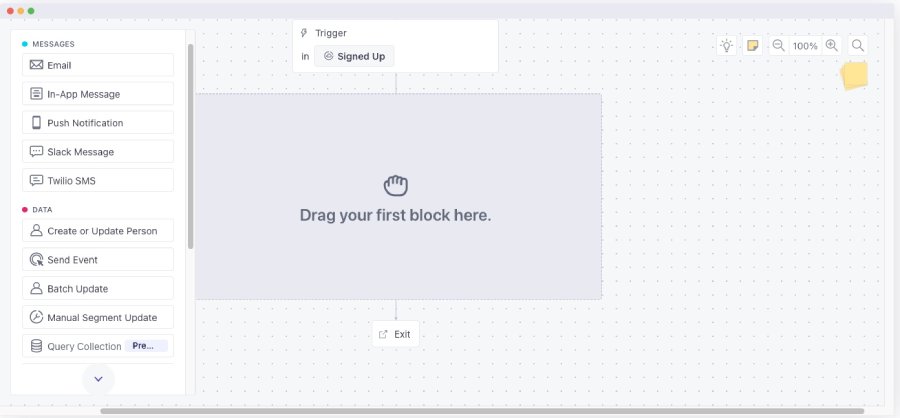
Customer.io creating journey workflows (Source: Customer.io)
Best Customer Experience & Insight Analytics Tools
One of the best retention strategies is focusing on customer experience (CX) management by ensuring all customers are satisfied and getting the maximum value from your product or service. Agents and CX managers can use these client retention software tools to obtain valuable feedback and produce the best possible experience for users and customers.
7. Qualaroo: Best for Obtaining Customer Feedback

Pros
- Unlimited surveys and collected responses for all plans
- System is easy to operate when designing and deploying surveys
- Platform provides advanced tools for obtaining feedback to improve customer experience
Cons
- Expensive platform all around
- Users only get one domain or “.com” on the Essentials plan
- Artificial intelligence (AI) feedback analysis is unavailable until the Business plan
- Survey management with templates: Teams can evaluate offerings and satisfaction using customer retention surveys sendable via email, on a company website, or through your mobile application using integrations. Users can also save time with premade professional surveying templates designed to quickly receive customer feedback.
- Customer feedback targeting: Teams can create workflow automations to auto-deploy feedback surveys with preset triggers, customer journey branching, and conditions. Targeted deployment is triggered based on customer activity or transactions.
- Advanced customer experience analytics: Survey analytics will calculate net promoter scores (NPS), customer satisfaction scores (CSAT), and customer effort scores (CES) to get the full scoop on customer experience. There are also artificial intelligence (AI) tools to help analyze customer sentiment and identify common feedback generated.
Qualaro uses a tiered subscription system for its users with the following plan options:
- Essentials: $79 for one domain
- Premium: $169 for two domains
- Business: $299 for unlimited domains
*Based on annual billing on a per-month basis. Monthly billing is also available for higher rates. Qualaroo offers an optional white labeling add-on for an additional $300 per year. Costs shown are based on the Contextual + Email Surveys product but users can subscribe to Email-only or Contextual-only for lower costs. Pricing reflects pricing info available at the time of publishing. While we update pricing information regularly, we encourage our readers to check current pricing here.
Our Expert Opinion
Customer experience is a key indicator of retention. That said, just about every type of business, regardless of industry, can benefit from a customer insights tool like Qualaroo. The intuitive interface and features make it an easy solution for creating surveys, collecting feedback, analyzing sentiment, and ultimately putting those insights toward improving your offerings.

Creating a new survey in Qualaroo (Source: Qualaroo)
8. Hotjar: Best for Retaining Website Visitors

Pros
- Free plan available
- Highly cost scalable as you mainly pay for the number of user website sessions observed
- Offers a unique set of data capture and recording features to help increase website retention and conversions
Cons
- Limited to just website analytics; customer feedback surveys require a separate product for an additional cost
- Getting user frustration and confusion signals for your website requires the expensive Business plan
- Website conversion tracking and session recording isn’t available until the Scale plan
- Automated web journey data capture: Businesses can connect their website and track user sessions automatically. This allows teams to understand web activity and common trends based on what customers are doing while on the site to improve user website experience. The tools also allow you to see actual recorded sessions made by website visitors.
- Heatmap tracking: You can use tools for reporting website activity as a heatmap showing the most heavily viewed and engaged elements on a site. These capabilities allow teams to improve copy, images, videos, web buttons, and other content based on how traffic is interacting with it currently.
- Website traffic dashboard analytics: Teams can identify trends on their website, such as frustration indicators and confusion signals that are limiting the customer experience. They can also look at funnel analytics showing conversion rates for different page calls to action (CTAs) and analyze why web visitors are dropping off.
Hotjar uses a tiered subscription system for its users based on the number of sessions or website journeys taken by customers with the following plan options:
- Free: $0 to track up to 35 daily sessions
- Plus: $32 to track up to 100 daily sessions
- Business**: $80 to track up to 500 daily sessions
- Scale**: $171 to track up to 500 daily sessions
*Based on annual billing on a per-month basis. Monthly billing is also available for higher rates. Hotjar offers a 15-day free trial. Pricing is based on the Observe product only. Teams can also purchase Ask modules to obtain feedback, Engage modules to interview customers, and a customized package for a higher price. Pricing reflects pricing info available at the time of publishing. While we update pricing information regularly, we encourage our readers to check current pricing here.
**Users can purchase more daily sessions on the Business and Scale plan for additional monthly costs.
Our Expert Opinion
Hotjar is a specialty customer retention technology designed to keep interested buyers on your website. It tracks and analyzes web traffic activity so you can find ways to improve page elements, increase conversions, and understand why certain web pages aren’t getting solid results. The platform is affordable overall as there’s a free-forever plan and scalable plans that steadily increase in cost as the number of web sessions recorded increases.
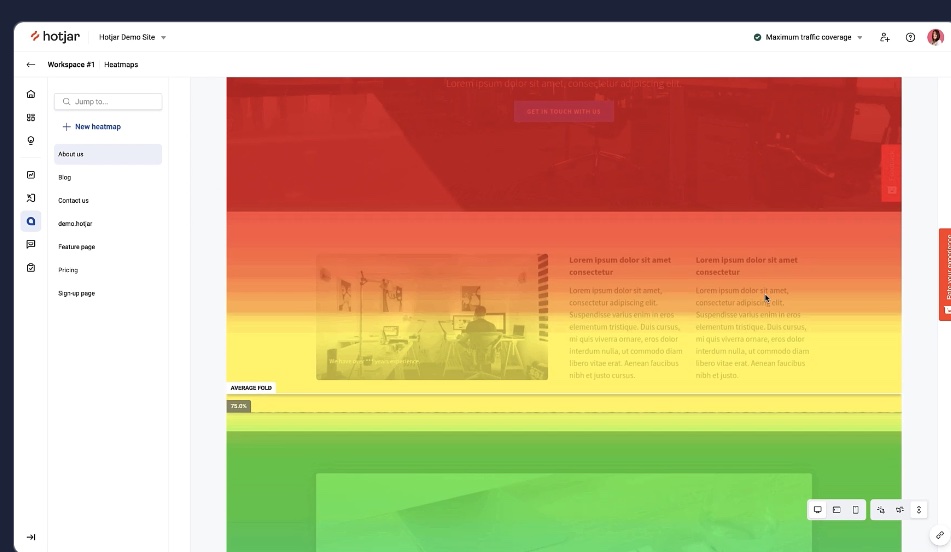
Hotjar viewing a website traffic heat map (Source: Hotjar)
Best Loyalty Management Tools
Loyalty management tools are a type of customer retention software that lets you boost recurring business by administering loyalty programs. These products help convert one-time purchasers into buyers with high customer lifetime value (CLV) by rewarding purchases with points or free offerings, using referral incentives, and deploying personalized marketing campaigns.
9. YotPo: Best for Administering Loyalty Programs

Pros
- Users can use the platform to deliver advanced loyalty programs based on customer profiles and behaviors
- Free plan lets you reward shoppers for creating an online account, making purchases, and referring business
- Lets teams give out various rewards like points, punches on a purchase punch card, free product redemptions, and discounts
Cons
- Non-transparent pricing for the Premium and Enterprise plans
- Rewarding customers for brand engagement and customer conversions requires Gold plan
- Shopify is the only free integration available on the platform
- Basic loyalty program earnings: Businesses can create and administer loyalty programs for their customers based on basic shopper profile attributes. For example, they can give points or other awards for someone purchasing a product, creating an online account, or having a birthday or loyalty program anniversary.
- Loyalty earnings for brand engagement: Businesses can tailor loyalty programs for advanced behaviors like brand engagement. They can award and track points or rewards to customers for interacting with social media posts, publishing online reviews, signing up for text or email campaigns, visiting web pages, making donations, and reading certain content.
- Conversion-based loyalty management: Businesses can set their loyalty programs based on spending, like hitting a certain money-spent goal, getting to their punch card purchase requirements, or purchasing a specific product. Users can also set advanced program settings like point expirations, tier-based VIP systems, and prescheduled reward earnings rules.
YotPo uses a tiered subscription system for its users based on the number of processed orders with the following plan options:
- Free: $0 for basic rewards programs
- Gold: $199 (includes 500 orders plus a per-order fee for each additional order)
- Premium: Contact for pricing
- Enterprise: Contact for pricing
*Based on annual billing on a per-month basis. Costs are based specifically on the Loyalty & Referrals product. Yotpo offers other retention products such as Reviews, SMS & Email, Subscriptions, and Visual UGC for an additional cost as well as bundled product options.
Pricing reflects pricing info available at the time of publishing. While we update pricing information regularly, we encourage our readers to check current pricing here.
Our Expert Opinion
YotPo’s Loyalty & Referrals product gives ecommerce businesses a central solution to creating, promoting, administering, and tracking customer loyalty programs. The great thing is that users can design their program for any type of reward, including points, discounts, free products, and coupons. It’s also flexible in terms of program triggers. Customers can get rewarded for profile attributes, brand engagement, purchases, and making referrals.
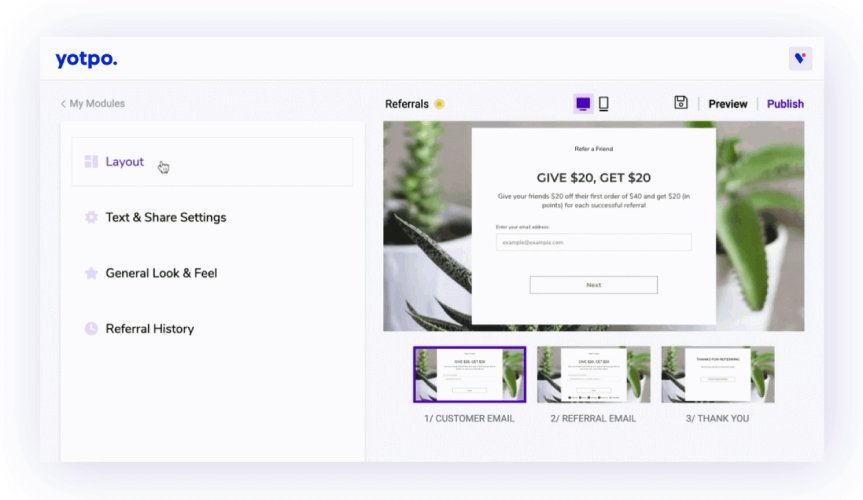
YotPo creating loyalty program marketing campaign (Source: YotPo)
10. Woorise: Best for Managing Contests & Giveaways

Pros
- Free and cost-scalable plans available
- Platform is highly intuitive for creating and promoting giveaway contests
- Excellent feedback-generating and assessment features for getting insights from customers, employees, and the general public
Cons
- Only one user allowed on Free and Basic plans
- Polling and surveying aren’t available until Grow plan
- Third-party integrations require higher-tiered plans
- Contest campaign delivery: Teams can create giveaway contents where customers can enter for a chance to win rewards. The platform has tools for promoting giveaways, publishing marketing content, and monitoring fraud detection. Users can also one-click select random winners and add contest restrictions based on geography or require validation codes to enter.
- Refer-a-friend management: Businesses can both retain current customers through contests and boost new engagement with refer-a-friend programs. This allows you to reward customers with additional entries for sending the entry link out to friends.
- Polling, quizzes, and surveys: Businesses can use polls, quizzes, and surveys to obtain customer feedback and contest entries to get insights on potential improvements. These tools are also flexible to use for evaluating customer satisfaction, net promoter score (NPS), and doing market research.
Woorise uses a tiered subscription system for its users with the following plan options:
- Free: $0 for up to 200 monthly contest entries and one user
- Basic: $23 for up to 2,000 monthly contest entries and one user
- Grow: $39 for up to 5,000 monthly contest entries and five users
- Pro**: $79 for up to 20,000 monthly contest entries and 10 users
*Based on annual billing on a per-month basis. Monthly billing is also available for higher rates. Woorise offers a 14-day free trial. Pricing reflects pricing info available at the time of publishing. While we update pricing information regularly, we encourage our readers to check current pricing here.
**Indicates starting price. More entries into a contest require a higher monthly cost.
Our Expert Opinion
One of the best ways to keep customers constantly engaged is by setting up contests and product giveaways. Woorise is the ultimate system for managing giveaway campaigns—letting you handle everything, including setting the contest rules, creating promotional ads and landing pages, collecting entries, and selecting a winner. It even extends its capabilities so you can maximize entries with a refer-a-friend feature and surveys to see how participants like your contest.

Woorise creating a landing page for a giveaway (Source: Woorise)
Best Messaging & Social Media Software
Messaging and social media software are used to keep engaged with customers through social media content and messaging channels. As many people spend lots of time on their favorite social accounts like Twitter, Facebook, LinkedIn, and Instagram, you can use these tools to always put your brand in front of them and keep them coming back for more purchases.
11. Buffer: Best for Cost-friendly Social Media Features

Pros
- Free plan evolves into a scalable solution as you primarily pay for the number of connected social channels
- Offers a wide range of connectable social media connections
- Users can design, write, schedule, publish, collaborate on, and monitor social content, all in one interface
Cons
- Relatively poor usability ratings for operating the social media tools
- Multiple users not available until the Team plan
- Reporting and analytics tools not available for free
- Robust integrations with social platforms: Users can connect with their customers on multiple social media platforms. These include popular ones like Instagram, TikTok, Facebook, Twitter, LinkedIn, Pinterest, and YouTube. There are also integrations with Google Business Profiles and Mastodon. Plus, the system lets you manage your own landing pages as well.
- Content planning and scheduling: Within Buffer, users can create, schedule, and publish content on their connected social accounts. They can do everything from drafting posts, tagging or mentioning users, creating hashtags, developing threads, and designing video thumbnails.
- Social analytics and reports: Teams can see how their content resonates with their customers using performance reporting and analytics tools. This allows you to view engagement and new followers, monitor social campaigns, and get insights on posts you chose to boost compared to organic views. There’s also audience analytics to see exactly who’s reading your content.
Buffer uses a tiered subscription system for its users based on the number of social channels connected with the following plan options:
- Free: $0 for one user and up to three social channels (up to 30 scheduled posts)
- Essentials: Starts at $5 for one social channel and one user, then $5 per additional channel (unlimited scheduled posts)
- Team: Starts at $10 for one social channel and unlimited users, then $10 per additional channel
- Agency: Starts at $100 for 10 social channels and unlimited users, then $60 for each additional channel
*Based on annual billing on a per-month basis. Monthly billing is also available for higher rates. Buffer offers a 14-day free trial. Pricing reflects pricing info available at the time of publishing. While we update pricing information regularly, we encourage our readers to check current pricing here.
Our Expert Opinion
Buffer offers the best cost-friendly customer retention management software if your strategy is to leverage social media for engagement. The platform offers tremendous value as you can connect to all the available social accounts for free to schedule and publish content. It’s also flexible in terms of content generation—allowing you to do mentions, tags, hashtags, images, video thumbnails, and embedded links within your posts.
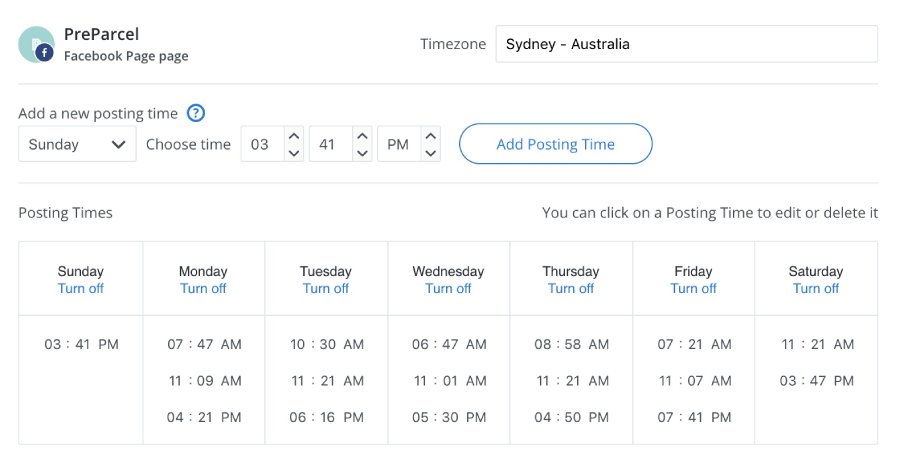
Buffer scheduling a Facebook post (Source: Buffer)
12. Sprout Social: Best for Customer Insights Through Social Media

Pros
- Lets you manage content and conduct customer surveys on social media sites
- Tons of integration options with popular sales, marketing, service, and ecommerce tools
- Unique tools for social listening to find keyword and hashtag trends you can deploy in your content
Cons
- Expensive platform all around
- Third-party integrations require the Professional plan
- Users can’t store a digital asset library of branded videos, photos, or other usable content until the Advanced plan
Our Expert Opinion
Sprout Social stands as a powerful social media management and customer feedback tool. We mostly like its advanced analytics features that allow you to track popular social keywords and trends, and surveying that lets you obtain valuable insights directly on a customer’s favorite social media system. We also can’t overlook the integration capabilities for teams to keep their customer data synchronized across all sales, marketing, and service platforms.

Sprout Social keyword trend listening on Twitter (Source: Sprout Social)
How We Evaluated the Best Customer Retention Tools
To evaluate the best customer retention tools, we broke down the specific types of software that can be used to execute a retention strategy: CRM systems, help desk software, automation tools, customer experience management systems, loyal management tools, and messaging and social media platforms.
We then evaluated relevant attributes for each product category. For example, CRMs should have a broad range of communication and customer tracking tools to best support their needs. Alternatively, loyalty management tools should have capabilities for delivering and tracking rewards programs for customer purchases. In addition to the features, we also looked at product affordability, customer support by the provider, and the intuitiveness of each software.
Frequently Asked Questions (FAQs)
A customer retention tool is any software that lets you maintain current buyers. Because many factors impact brand loyalty, retention tools can consist of a wide range of products. For instance, customer service systems let you efficiently handle support tickets to maximize service quality. Alternatively, loyalty program tools allow you to administer rewards for repeat purchases, while marketing automation platforms let you stay constantly engaged with customers.
Customer relationship management (CRM) lets you oversee the sales process, leads, deals, and customers while allowing you to store data and communicate with contacts. On the other hand, customer retention is the process of bringing back buyers and retaining client relationships. Because of the many features and integrations within the software, a CRM is a great customer retention tool that lets you monitor, engage, and support customers.
Bottom Line
Customer retention is vital to sustainable business growth. Various customer retention software products can be used to deliver, automate, and track performance for your retention campaigns. But which tool you need depends on your business type and sales and marketing strategies. A CRM like Freshsales, for example, has activity tracking and communication tools to support customers, while a customer analytics tool lets you get feedback to improve your offerings.